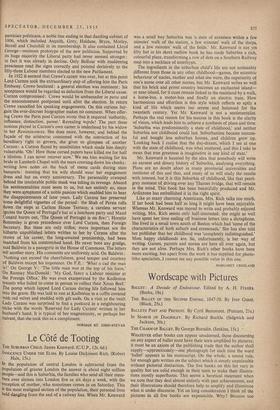Wordscape with Pictures
BALLET: A Decade of Endeavour. Edited by A. H. Franks. (Burke, 18s.)
THE BALLET OF THE SECOND EMPIRE, 1847-58. By Ivor Guest. (Black, 25s.) BALLETS PAST AND PRESENT. By Cyril Beaumont. (Putnam, 21s.)
THE CHARM OF BALLET. By George Borodin. (Jenkins, 15s.)
WHATEVER other books can appear unadorned, those discoursing on any aspect of ballet must have their texts amplified by pictures; it must be an axiom of the publishing trade that the author shall supply—approximately—one photograph for each time the word 'ballet' appears in his manuscript. On the whole, a sound rule, for enough gets written on the subject which is simply unpalatable without pictorial distraction. The five books on this list vary in quality but are solid enough in their texts to make their illustra- tions mostly superfluous. This seems a heretical statement when we note that they deal almost entirely with past achievements, and their illustrations should therefore help to amplify and illuminate what is under discourse. Yet on long consideration I think all the pictures in all five books are expendable. Why? Because too
few really add anything to what the text says; too many are shabbily reproduced; too many, even when well chosen and well printed, tend to distract from, rather than add to, what the authors have to say on that given person, ballet, or moment of ballet's history. The pictures decorating this particular word- scape are mostly characterless shrubs distorting both foreground and middle distance—not splendidly placed trees which both grace the view and give perspective and proportion to the distance. Arthur Franks and his contributors survey dancers, ballets, trends of policy, the arts ancillary to ballet and balletography, during the past ten years. Not much original vision and few significant deductions, but some useful slabs of fact (not all complete); directors of ballets should have their work discussed, not be encouraged to explain their success in their own words. The pictures, mostly portraits of dancers, are good and well printed.
Mr. Guest's conducted tour round the Paris Opera Ballet of 100 years ago is solidly factual and fascinating about ballerinas, ballets and choreographers; the period illustrations include lots of fiendish caricatures and solemn photo-portraits, and one or two reproductions of decor. Mr. Beaumont adds analyses of over fifty ballets, ancient and modern, to his ever-expanding catalogue of the works created in the past century and a half, wherever ballet has been made; portraits alternate with stage views of ballets in action, most of the latter confusing rather than elucidat- ing what the works are supposed to be about.
Although Mr. Buckle—and many other people—put in some hard work to arrange the Diaghilev Memorial Exhibition, this book celebrating the event, and amplified with more than 200 illustrations, seems to me interesting only to those who felt the impact of the Diaghilev Ballet. Those who missed that experience may regret it, or admit their inability to see what it was all about; certainly, despite the millions of words written on him, the last has not yet been heard of him. Very little that is new—or com- pletely credible—comes out of these pages.
Mr. Borodin has wrestled with his memories (and his typewriter) at some length in an attempt to put ballet, and the average ballet- goer, through a deep analysis which will yield up the explanation of why the audience finds itself in the theatre night after night without, I think, much success. His portraits include many familiar faces and some dancers who have never been heard of outside the (presumably) provincial towns where they trained.
Of all five, the illustrations to Mr. Guest's and Mr. Buckle's books are most consistent and most revealing, though they leave a sense of incompleteness; layouts and quality of reproduction are very fair. No single point of either Mr. Frank's compilation or Mr. Borodin's essay gains anything from any single picture; and here and there the effect of Mr. Beaumont's historical notes is actually blurred by the unrevealing illustrations. Altogether, five visions of the world of ballet in which the pictorial ingredients distract irritatingly or profoundly from the perspective their authors, I feel certain, mean us to behold.
A. V. COTON



































 Previous page
Previous page